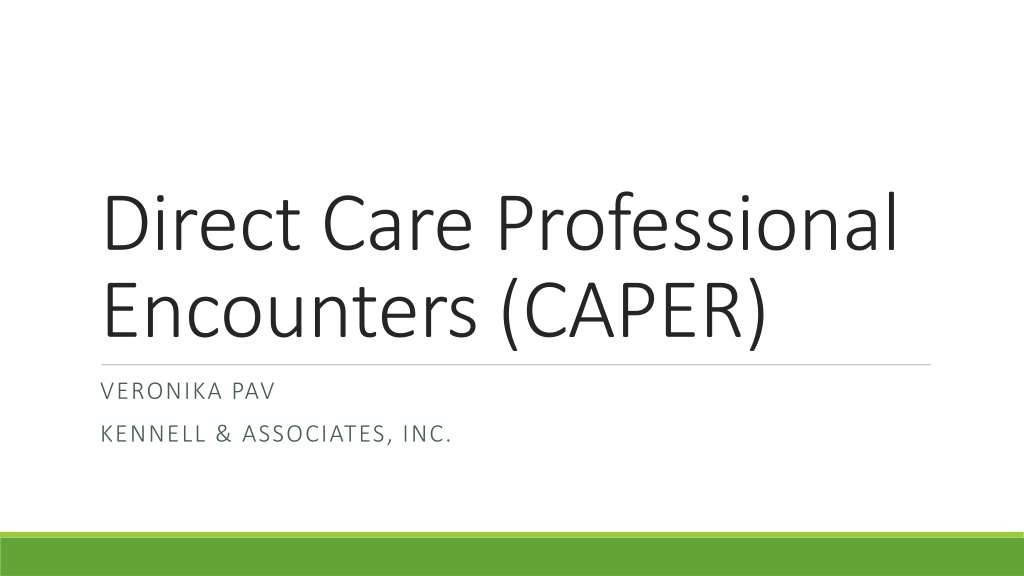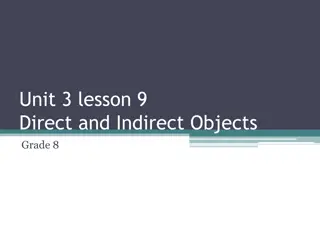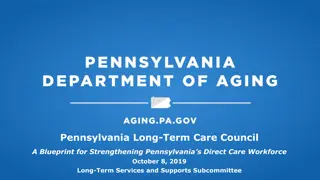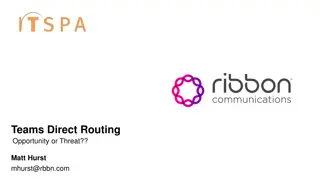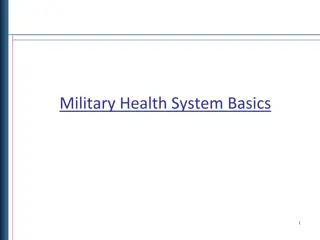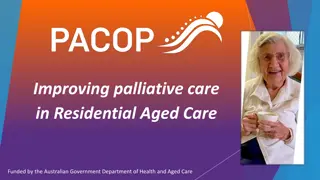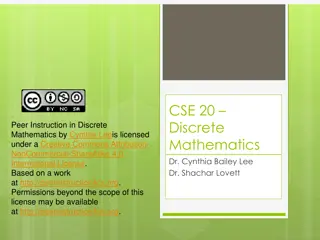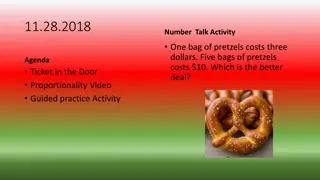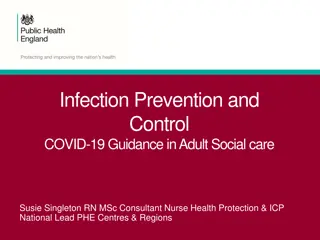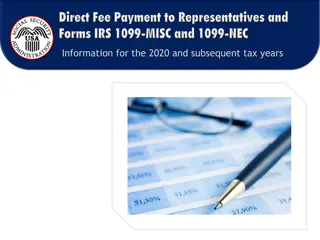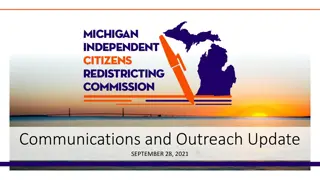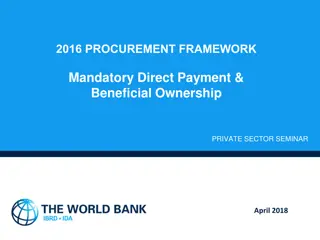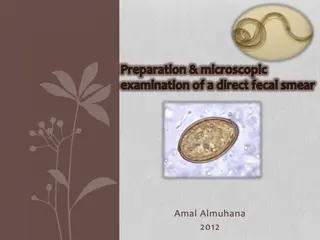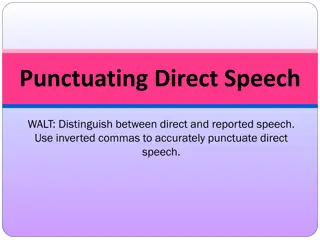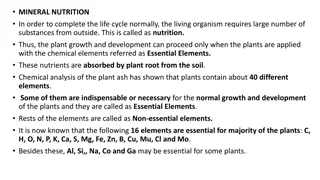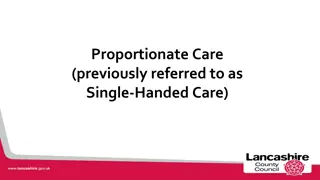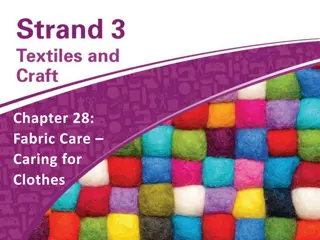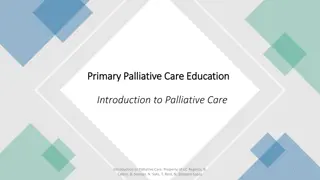Understanding Direct Care Professional Encounters (CAPER) and Key Elements
This content explores the characteristics of Direct Care Professional Encounters (CAPER), highlighting key elements and workload measures. It covers common terms, objectives, and coding compliance requirements related to healthcare encounters between patients and caregivers. The file also discusses telephone consults and record definitions for various encounters in healthcare settings.
Download Presentation

Please find below an Image/Link to download the presentation.
The content on the website is provided AS IS for your information and personal use only. It may not be sold, licensed, or shared on other websites without obtaining consent from the author. Download presentation by click this link. If you encounter any issues during the download, it is possible that the publisher has removed the file from their server.
E N D
Presentation Transcript
Direct Care Professional Encounters (CAPER) VERONIKA PAV KENNELL & ASSOCIATES, INC.
Objectives Objectives Describe the characteristics of a Direct Care Professional Encounter Record Highlight key elements Describe workload measures 2
Common Terms Common Terms National Provider ID HIPAA Taxonomy Code ICD Diagnosis Code CPT/HCPCS Code MDC APC Basic Workload Person IDs Bencat/Bencat Common PCM ID, PCM Type Enrollment MEPRS Code Deployment Information Geography Tmt DMIS ID MEPRS Code ICD Procedure Code CCS Category MS-DRG Service Dates Weighted Workload Demographics HCDP, ACV Group, Enrollment Group Enrollment Site Eligibility Group Raw vs Total Record ID 3
This includes telephone consults too! What s in the File? What s in the File? Record definition: Record definition: one healthcare encounter between a patient and one or more MTF caregivers. Encounters in ambulatory clinics, including those by inpatients (MEPRS B) Inpatient provider records (MEPRS A) Rounds and Inpatient surgeries/procedures Case Management (MEPRS E and F) Immunizations (MEPRS FBI and BHZ) Hearing Conservation (MEPRS FBN) Some ancillary activities (in clinic) For example, in clinic ultrasounds 4
Encounters Encounters by FY and MEPRS1 Code by FY and MEPRS1 Code A Inpatient B Ambulatory C Dental D Ancillary E Support F Spec Pgms G Readiness Sum: 926,540 38,028,266 18,675 91,953 428,125 2,842,136 2012 42,335,695 876,145 39,298,569 18,197 86,898 461,417 2,850,829 2013 43,592,055 883,264 38,433,080 13,175 62,149 535,453 2,767,189 2014 42,694,310 889,766 38,843,290 13,448 35,892 554,471 2,732,518 2015 43,069,385 888,468 39,800,085 12,316 43,121 537,930 2,674,454 5 2016 43,956,379 905,157 40,138,035 13,013 32,756 621,292 2,549,842 2017 44,260,095 587,781 28,813,941 9,565 20,549 410,017 1,788,288 2 2018 31,630,143 *Data as of 7/11/18
Coding Compliance From the appointment file, we know that an encounter occurred or was Kept . For these Kept appointments, the inferred records are kept as place holders until the records are coded. Timeliness: Timeliness: Requirement to complete CAPER within 3 business days of encounter; 15 days for APVs - not 100% met Completeness: Completeness: Some records not received at all 6
Inferred CAPERs Completed encounter records compared to appointment records. Missing encounters inferred from appointments oPerson information to add enrollment, etc. oNo diagnosis or CPT codes Workload and cost measures inferred by Tmt DMIS ID, visit class (APV, Telcon, Other), and MEPRS3 Code Identified using Compliance Status (APPTINF) oI = Encounter record that has not been coded oR = Coded encounter 7
Appointment AppointmentStatus Status FY 2014 Percentage: 2015 Percentage: 2016 Percentage: 2017 Percentage: 2018 Percentage: Appt Status Class Encounters Encounters Encounters Encounters Encounters Appointment Status Code Appt Status Desc 4 0.0% 18 0.0% 6 0.0% 24 0.0% 1 Pending SEEN 23,367,967 54.8% 23,429,133 54.5% 23,931,926 54.5% 23,917,580 54.1% 16,979,273 53.9% 2 Kept SEEN 9,941,155 23.3% 9,543,258 22.2% 9,365,920 21.3% 9,555,836 21.6% 6,971,268 22.1% 5 Walk-in SEEN 294,083 0.7% 217,555 0.5% 191,577 0.4% 166,626 0.4% 125,189 0.4% 6 Sick Call SEEN 9,012,413 21.1% 9,826,428 22.8% 10,428,371 23.7% 10,569,377 23.9% 7,439,016 23.6% 7 Tel Con TELCON 98 0.0% 66 0.0% 71 0.0% 104 0.0% 30 0.0% 9 Unknown SEEN Sum: 42,615,720 43,016,458 43,917,871 44,209,547 31,514,776 *As of 7/11/18, Reported only 8
Identifying a Record The Appointment IEN (APPTIDNO) and the CHCS Host DMIS ID (HOSTDMIS) create a unique ID for each encounter in the CAPER file. Note: Linkages in CHCS enable users to link encounters to other files (e.g., pharmacy, ancillary, inpatient) using this this Record ID, but name of the variable APPTIDNO has variations across files (e.g. APPTIEN in Pharmacy-PDTS). 10
Disposition Code Disposition Code Numeric codes used for ambulatory care Released (e.g., 1) Referral (e.g., 4) Admitted (e.g., 7) Character values used for inpatient rounds care values resemble those in inpatient data Transfers (e.g., A) Routine Disposition (e.g., F) 11
Date Fields Date Fields Encounter Date Encounter Date = Date of encounter FY/FM FY/FM and CY/CM CY/CM = the year and month of the Encounter Date 12
Provider Data Provider Data Provider field, which provider Provider field, which provider Provider Provider information available for Appt, Addtl 1 - Addtl 4: Provider Identifiers: EDIPN, NPI, ID Mil Status: Active, Civilian, Guard, etc. Role: Attending, Assisting, Nurse, Para-Prof, etc. Specialty: 001 Fam Practice Physician Specialty HIPAA: 207Q00000X Family Practice Skill Type (CHCS) (e.g. 1&2 privileged providers, 1R = Interns/Residents with License, 3 = Nurse Techs, 4 = Direct Care Para- Professionals, Residents w/o License) CAPER Skill Level (HIPAA-based) Assignment info (from DMHRSi) Provider Provider information available for Referring Provider: EDIPN, NPI, ID, and DMIS ID 13
Procedure ProcedureData Data Category E&M 1 E&M 1-2 E&M 1-3 Other Combo No E&M XXXXX Total Encounters Percent Cumulative 37,719,742 94.2% 428,305 1.1% 13,782 0.0% 338 0.0% 732,820 1.8% 1,151,402 2.9% 40,046,389 100.0% 94.2% 95.3% 95.3% 95.3% 97.1% 100.0% Coded with CPT/HCPCS from CHCS Evaluation & Management Codes: CPT_1-CPT_3 Procedure 1 Procedure 10: CPT_4-CPT_13 No Proc Proc 1 Proc 1-2 Proc 1-3 Proc 1-4 Proc 1-5 Proc 1-6 Proc 1-7 Proc 1-8 Proc 1-9 Proc 1-10 Other Combo XXXXX Total 21,666,058 9,292,628 5,208,422 1,915,712 917,048 364,298 190,876 102,811 43,378 37,407 153,416 12,695 141,640 40,046,389 54.1% 23.2% 13.0% 4.8% 2.3% 0.9% 0.5% 0.3% 0.1% 0.1% 0.4% 0.0% 0.4% 100.0% 54.1% 77.3% 90.3% 95.1% 97.4% 98.3% 98.8% 99.0% 99.1% 99.2% 99.6% 99.6% 100.0% All blank on Inferred records XXXXX are CPT removed due to code editing *As of 7/11/18, FY17 reported, DHP sites and MEPRS B only 14
Modifiers Modifiers E&M Code E&M Code # # Modifier Procedure Procedure # # Modifier Modifier # # Modifier # # Up to 3 modifiers per Procedure Modifier 1: Policy says code if it affects RVU Modifier 2-3: Additional information Directly affect RVU choice from table or later calculations E&M Code 1: CPT_1 Modifiers: CPTMOD1_1 CPTMOD2_1 CPTMOD3_1 15
Quantity Quantity E&M Code E&M Code # Quantity, Raw & # # Quantity, Raw & # Quantity, Adjusted Procedure Procedure # Quantity, Raw & # # Quantity, Raw & # Quantity, Adjusted Quantity, Adjusted Quantity, Adjusted Quantity: the number of times the procedure was performed Also referred to as Units of Service (UOS) CPT Units of Service, Adjusted (cptuos1-cptuos13) Reduced when reported in excess of UOS limit Used in RVU calculations CPT Units of Service, Raw (cptunits1-cptsunits13) 16
Quantity QuantityAdjustments Adjustments UOS exceeded limit for all 3 procedures; changed to UOS substitute Change Edit Flag*=1 (Units of Service changed, exceeded limit) UOS Edit Flag=Y E&M1 Procedures Quantity RVU 64614-Destroy Nerve Extrem Muscle 64612-Destroy Nerve Face Muscle 64613-Destroy Nerve Neck Muscle 64614-Destroy Nerve Extrem Muscle 64612-Destroy Nerve Face Muscle 64613-Destroy Nerve Neck Muscle 10 20 10 2 2 2 Original 99213 129.67 Corrected 99213 21.05 Difference 108.62 *We haven t discussed the Edit Flags yet, but we will. 17
Ambulatory Ambulatory Payment APC E&M # APC E&M # APC Proc APC Proc # # Payment Classification Classification Assigned based on CPT codes Applied to CAPER B MEPRS, Facility Records Each CPT code results in an APC, max 13 per record APC Status Code (apcpsi1-apcpsi13) Used in RVU for multiple procedure discounting Uses: Workload measurement, cost application and analysis, and PPS 18
APC APCWeights Weights Applied to every APC on a B MEPRS, Facility Record Adjusted for quantity and discounted per Status Code* Summed as APC Aggregate Weight * We haven t discussed discounting yet either, but we re getting there. 19
Facility/Non Facility/Non- -Facility Flag Facility Flag N F R Office Away from Office (aka Facility) (Military Hospital) (aka Non-Facility) (Doctor's Office) Resource Sharing (Civilian Hospital) Provider Work RVU Work RVU Work RVU Practice RVU, Away from Office Practice RVU, Away from Office Practice Practice RVU, Office Facility APC Weight* Military Doctor delivers baby downtown Annual check-up with Doctor in Office MEPRS A, ER, SDS, Cardiac Cath Example *Except MEPRS A (being evaluated) Affects provider practice and facility workload assignment, specifically, Practice Expense RVU, and APC weight used for PPS 20
Relative RelativeValue ValueUnits Units Numeric values that quantify relative workload and costliness of health care services Emphasizes contribution by provider and practice 3 components: Work Practice Expense (PE) Office or Away From Office Malpractice (Not used with Direct Care) Applied to each CPT/modifier combination Simplistically, total RVU = (RVU * Quantity) for all CPTs 21
Enhanced [Work, PE, Total] RVU Enhanced [Work, PE, Total] RVU Aggregate measures based on 13 CPTs, modifier impact, quantity adjusted (UOS limits applied), code edits, nurse credits One choice for direct vs. purchased care ambulatory comparison DC: MEPRS B, FBI, FBN PC: Place of Service = 11, 20, 22, 23, 24, 53, 60, 65, 71, 72, Program Indicator Code not equal D. Willl have to build episodes to create encounters Direct and Purchased Care professional inpatient data collection are different and not comparable (but it s getting better) Best measure to compare to Purchased Care (TED-NI) 22
Provider ProviderAggregate AggregateRVUs RVUs Aggregate measures based on 13 CPTs, modifier impact, quantity adjusted (UOS limits applied) Code editing and the Change Edit Flags Additional modifier effects Multiple procedure discounting Provider impact Multiple provider credit Nurse credit code (Unlicensed residents when not supervised) Provider Aggregate is for the encounter, not a single provider! 23
Change ChangeEdit EditFlag Flag Records up to 10 different edits to various fields Data Quality Flags Y or N values Bilateral Code Edit Flag UOS Edit Flag Prov/Proc Linkage Edit Flag Surgical Follow-up Edit Flag TCON Edit Flag Purposes: Corrects known mis-coding problems (e.g., coding bilateral modifier AND quantity = 2) Fixes missing data (e.g., all E&M provider pointers are missing) Implements policy decisions (e.g., credit reassigned to Appt provider (physician) when additional provider 1 (nurse) is the only provider linked to a procedure) *except CPT Quantities 24
Code Editing and Modifier Effect: Surgical Follow Code Editing and Modifier Effect: Surgical Follow- -up up E&M1 99214 99214 XXXXX Proc/Mod S0810/55 S0810/55 S0810/55 RVU 21.57 4.59 1.55 20.02 w/o mod impact or code edit w/ adjustment for surg follow-up modifier w/mod impact and code editing Difference RVUs for S0810 (PRK) removed because modifier 55 indicates postoperative management only RVUs applied for surgical follow-up (per 99024) E&M Code and E&M RVUs Removed Change Edit Flag=78 7 Surgical Follow-up (credited as 99024) 8 Surgical Follow-up (no credit for E&M) Surgical Follow-Up Edit Flag=Y 25
Code CodeEditing: Editing:TELCONS TELCONS Appointment Status=7 Non-TELCON Procedure RVUs removed Change Edit Flag = B (TELCON No additional credit for non-TELCON procedures) E&M1 Proc / Mod RVU 61533-Implant Brain Electrodes 61536-Removal of Brain Lesion w/o code edit 99441 76.72 61533-Implant Brain Electrodes 61536-Removal of Brain Lesion w/ code edit (Prov Agg RVUs) 99441 0.35 Difference 76.37 26
Inputs to RVUs Inputs to RVUs Raw Materials: E&M and Procedure Codes Modifiers Quantity (Units of Service) Facility/Non-Facility Flag And these for just Provider Aggregate: APC Status Code Used to determine procedure discounting Up to 3 Providers (Appt Prov and Additional Prov 1-4) Provider Specialties Provider/Procedure Pointers (not available in DAVINCI) Actions: Apply cleanup, modifier impact, multi-procedure discount, nurse credit, and multiple provider credit 27
Weighted WeightedWorkload WorkloadRecap Recap Enhanced [Work, PE, Total] RVU Modifier effects Units of Service limits applied Miscoding corrected Nurse Credit E&M # Work or PE RVU, NPA (#=1 E&M # Work or PE RVU, NPA (#=1- -3) and 3) and Proc Proc # # Work or Work or PE RVU, NPA PE RVU, NPA (#=1 (#=1- -10) 10) these are Non these are Non- -Provider Affected (NPA) RVUs Provider Affected (NPA) RVUs Provider Aggregate [Work, PE, Total] RVU these additional items are performed for Provider Aggregate Multiple procedure discounting Multiple provider participation Provider [Work, PE, Total] RVU, Appt Prov and Addl Provider [Work, PE, Total] RVU, Appt Prov and Addl Prov Prov # (1 # (1- -2) 2) APC Aggregate Weight on Facility, B MEPRS records only Provider Aggregate and APC Aggregate Weight used in PPS Remember Provider Aggregate RVU is for the encounter, not a single provider 28
Odds and Ends Odds and Ends MHS Genesis IOC no CAPERs as of these dates Fairchild: 2/7/17 Bremerton: 9/23/17 Oak Harbor: 7/15/17 Madigan/McChord: 10/21/17 Analyzing patterns Deployment of providers with no-to-slow backfill Snowbird effect (impact on cold/warm-climate sites) Coding practices ICD-9 vs ICD-10 diagnosis code changes o In ICD-10, no longer have extenders. See DOD unique codes (all start with DOD) Inpatient CAPERs ( A CAPER) are being used for PPS and Provider Productivity o Creating A CAPER for Rounds are not really an issue o A CAPER for inpatient procedures (MD performs coronary bypass) are at issue. Provider might be coding in Essentris and have no knowledge that workload is not being captured they think they have done everything but the MTF should be ensuring it goes through.
Odds and Ends Odds and Ends Continued Continued Increasing use of ICD-9 diagnosis V68.9 Unspecified Administrative Purpose and Z02.89/Z02.9 Encounter for Other/Unspecified Administrative Examinations We *think* these have been created to get documentation on the record not that an actual encounter happened. V68.89 is supposed to be used when provider s documentation is unavailable. These are actual encounters but again, they do not have an actual diagnosis code on them. *Estimated based on 10 months worth of data.
Questions Questions vpav@kennellinc.com 31
